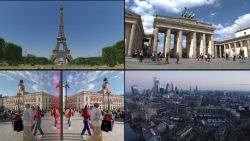Staging a home that’s up for sale is a go-to marketing tool that has been used for decades. Bringing in furniture, artwork and plants and decluttering rooms can help buyers picture themselves living in the home.
Agents say it can decrease the home’s time on the market and may even boost the sale price. But it can also be a costly hassle.
More from Success
“Staging is expensive and cumbersome,” says Jorge L. Guerra Jr., the president and chief executive officer of Real Estate Sales Force in Coral Gables, Florida. “It requires taste and design to do it correctly.”
That’s why many agents are turning to virtual staging, a vastly cheaper and easier option.
‘The first showing happens online’
“It is no longer about curb appeal, it is about web appeal,” says Guerra. “The first showing happens online. The consumer has 3 to 4 seconds to make a decision: Do I want to see this or not? With such little time, you want to be sure you have your best pictures upfront.”
By providing an image of an empty room to a virtual staging service that digitally enhances it with a high-end sofa and thoughtfully placed art work, agents and homeowners avoid the hassle of hauling in a whole new look. Plus, it’s a fraction of the cost.
“My average staging can cost between $4,000 to $8,000,” says Guerra. “Virtual staging will cost me $100 to $150.”
He says that in today’s world, buyers are looking at pictures online and they need furniture in the space to imagine it.
For some of Guerra’s properties, the rooms are not actually empty. They have a large easel holding a picture of the virtual staging, so that potential buyers can see itwhile standing in the empty room.
Ines Hegedus-Garcia, of Avanti Way Realty in Miami, even offers virtual reality glasses in some properties to give potential buyers the staged experience.
“They are walking the virtual realty tour in the home,” says Hegedus-Garcia. “But they are also able to see in person what the space actually looks like.”
Even traditional stagers, like Nadia Vee, a designer based in Long Island, New York, says that virtual staging has a place.
When she recently staged a six-bedroom luxury home, she physically designed five main rooms – the kitchen, living room, dining room, bedroom and bath. But there were a few other spaces she felt buyers needed help to visualize.
So she virtually staged the guest bedrooms and a home office and placed an image in each room, along with one item, a chair, maybe, or a desk.
“It is very helpful for people who saw the first glimpse of the home online to see the idea of it in person,” she says.
Presenting a true picture
The National Association of Realtors encourages agents to clearly disclose if photos have been altered in any way to avoid any confusion for viewers, but it is not required.
Still, each multiple listing service has its own guidelines. In Chicago, for example, the first photo on the listing must be an exterior photo and when uploading images the system will ask if the image has been altered, according to Marc Avila, an agent in the city who also owns a virtual staging company there.
Several years ago he began to virtually stage his own properties. When colleagues came to him with their requests, he decided to set up shop. He now runs Virtual Staging House, which can provide a virtually staged image within 24 hours for $40.
“The market right now is about how fast you can get those images up and how appealing they are,” says Avila. “People are looking at the listing online first. It better be the best image. You want it to bring an army of buyers to inquire about the listing.”
The affordability of virtual staging has made staging a newly available marketing tool for properties that may not have otherwise gotten the treatment.
Laura Copersino, an agent with Douglas Elliman, works in the mid-level market in Queens and Nassau Counties in New York, where physical staging was rare due to cost and hassle, she says.
But now if she has an empty property, she virtually stages it with furniture and artwork.
She ensures there is no confusion about the images by posting the virtually staged image on MLS followed by the empty room.
“I use a company that charges $35 a photo with a 24-hour turnaround,” she says. “You can pick out the style of the furniture, the artwork on the wall. It’s like you’re shopping!”

Some agents have concerns that staging virtually can lead to misleading representations of the home.
“Being truthful in advertising is the number one concern for me,” says Katie Griffin Ross, a broker associate at RE/MAX Associates in San Antonio, Texas. “It is difficult for people to be in a house and not see what they saw online.”
While she does, on occasion, use virtual staging, she has lines she won’t cross. She won’t make a dead yard alive, she won’t crop out power lines, and she’s careful about including any virtual window coverings that may be misunderstood to be part of the house.
But Guerra sees things differently. He values the power of virtual staging. For a few dollars he can can stage the weather or time of day on an exterior picture.
“The technology is now at the point that not only can I stage the inside, I can stage the clouds,” he says.


























